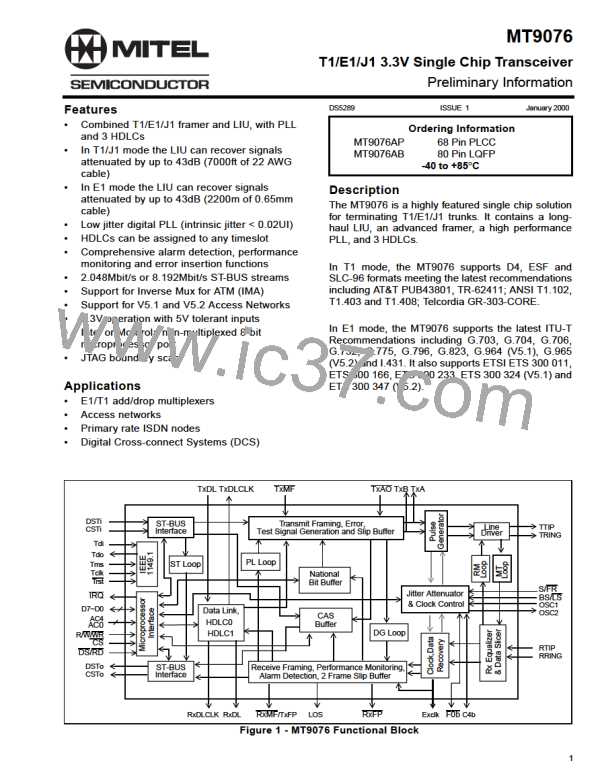MT9076
Preliminary Information
Channel Associated Signaling
•
•
•
•
•
•
•
ABCD or AB bits can be automatically inserted and extracted
Transmit ABCD or AB bits can be passed via the microport or via the CSTi pin
Receive ABCD or AB bits are accessible via the microport or via the CSTo pin
Most significant or least significant CSTi/CSTo nibbles can be selected to carry signaling bits
Unused nibble positions in the CSTi/CSTo bandwidth are tri-stated
An interrupt is provided in the event of changes in any of the signaling bits
Receive signaling bits are frozen if signaling multiframe alignment is lost
T1/J1 Mode
E1 Mode
•
Signaling bits can be debounced by 6 ms
•
Signaling bits can be debounced by14 ms
Alarms
T1/J1 Mode
E1 Mode
D4 Yellow Alarm, two types
Remote Alarm Indication (RAI)
• Bit 3 of the receive NFAS
1. Bit position 2 is zero for virtually every DS0
over 48ms
2. Two consecutive ones in the S-bit position of
the twelfth frame
Alarm Indication Signal (AIS)
•
Unframed all ones signal for at least a double
frame or two double frames
ESF Yellow Alarm, two types
1. Reception of 0000000011111111 in seven
or more codewords out of ten (T1)
Timeslot 16 Alarm Indication Signal
All ones signal in timeslot 16
2. Reception of 1111111111111111 in seven
or more codewords out of ten (J1)
•
Loss Of Signal (LOS)
Alarm Indication Signal (AIS)
•
Analog Loss Of Signal is declared if the
received signal is more than 20 dB or 40 dB
below nominal for at least 1 ms
•
Declared if fewer than six zeros are detected
during a 3 ms interval
•
•
Digital Loss Of Signal is declared if 192 or 32
consecutive zeros are received
Loss Of Signal (LOS)
•
Analog Loss Of Signal is declared if the
received signal is more than 20 dB or 40 dB
below nominal for at least 1 ms
Output pin indicates LOS and/or loss of
frame alignment
Remote Signaling Multiframe Alarm
Y-bit of the multiframe alignment signal
•
•
Digital Loss Of Signal is declared if 192 or 32
consecutive zeros are received
•
Output pin indicates LOS and/or loss of
frame alignment
14

 MITEL [ MITEL NETWORKS CORPORATION ]
MITEL [ MITEL NETWORKS CORPORATION ]